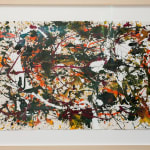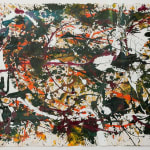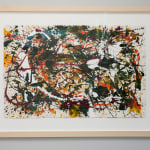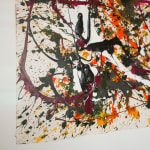




William Alpert
31 3/4 x 50 3/4 inches (framed)
Further images
Provenance
Ex. coll: The artist; Wade Gallery, Washington, DC 1978; to Corporate Collection, Northeast USA until November 2020.
Exhibitions
Exhibited: Wade Gallery, 1726 Twenty-First Street, NW, Washington, DC. October 7-November 31, 1978. Bill Alpert: Paintings, Drawings and Sculpture.
William Alpert
American (1934-2015)
Untitled
acrylic on handmade paper
25 ½ x 40 inches
31 ¾ x 50 ¾ inches (framed)
Signed on verso
1978
Ex coll: The artist; Wade Gallery, Washington, DC 1978; to Corporate Collection, Northeast, USA until November 2020.
Exhibited: Wade Gallery, Washington, DC, October 7 - November 31, 1978
Label: Bill ALPERT / Paintings, Drawings, Sculpture / Oct. 7 - November, 1978/Wade Gallery / 1726 Twenty-First Street, N.W. / Washington, D.C. 2009
Framed to museum conservation standards, work floated on a white acid free mat in a maple frame with Optium acrylic.
Bill Alpert was a highly educated, cerebral artist with a superb sense of color and rhythm. He approached his work with the investigative proclivities of a scientist, exploring the materiality of surface and the characteristics of paint in his art. Art expressed his formidable intellect and was an outlet for his creative spirit.
A native of the Bronx, NY, Alpert's Russian/Polish émigré father owned and operated a drug store. Alpert moved to Los Angeles for college, completing his doctorate in pharmacology at the University of Southern California in 1958. He quickly became disillusioned, enrolled at UCLA to pursue a BFA in painting and completed it in 1963. Two years later, Alpert received his MFA after studying painting with Arthur Levine and print making with John Paul Jones. 1965, the year Alpert finished his UCLA MFA, he began exhibiting at the pioneering LA coop gallery, Czeka. By 1968 Alpert had returned to his native New York and was exhibiting in the city.
The 1970's and 1980's were the most productive and successful for Alpert. The artist's solo exhibition at Wade Gallery in Washington, DC in 1978 (in which this work on paper, Untitled, was shown), garnered favorable reviews in the press. The Washington Post wrote, "Alpert is a prolific virtuoso of both color and form, and with astounding gusto…Alpert's work is upbeat and fun, and his vitality infectious." In the early 1980's many leading NYC artists like Alpert incorporated street art into their work. Alpert used graffiti verbiage and geometric designs in the work he exhibited at the Ben Shahn Gallery at NJ's William Patterson College. Critic David Shirley of the New York Times commented on Alpert's Memories on view at that venue, "Subway graffiti artists might take a lesson from this man."
By the late 1980's Alpert became disillusioned with the commercialization and financialization of the art market in general, and more specifically, his own work. (Michael Shnayerson's book, Boom: Mad Money, Mega Dealers and the Rise of Contemporary Art. New York: PublicAffairs, 2019., is a fascinating exploration of this phenomenon.) He began teaching painting at Cooper-Union School of Art as an Adjunct Professor around 1980 and by the end of the '80's, the transition to teaching was complete. Although no longer exhibiting, Alpert remained a practicing artist even if his professional focus was teaching - at Cooper-Union, Parsons, Pratt and SVA - and writing for a number of publications.
Untitled 1978 is a powerful, large-scale, Abstract Expressionist work on paper. It is from Alpert's most critically acclaimed period. It exemplifies what one of his dealer's says about the artist; "the exploration of the characteristics of the paint itself - its' viscosity and color, stain vs. regular oil paint, how it was absorbed or pooled on different surfaces and how it reacted to those surfaces. He was particularly drawn to paint on different types of paper…Out of this process, he created works that grab the mind and eye."
Noteworthy exhibitions of Alpert's work:
Works on Paper Exhibition, Bard College, Annandale-on-Hudson, NY 1972; Organization of Independent Arts (OIA) Postcard Show (traveling), Bologna, Italy, PS1 New York, NY, Albright-Knox Museum, Buffalo, NY, 1978; Bill Alpert: Paintings, Drawings, Sculpture, Wade Gallery, Washington, DC, 1978; 24 x 24, St. Lawrence University, Canton, NY, 1979, Current/NY, Lowe Art Gallery, Syracuse University, Syracuse, NY, 1980; Collections: Power Gallery of Contemporary Art, Sydney, Australia, 1983; William Halsey Gallery, College of Charleston, SC, 1986 (solo), 1987, 1988; Artists in Paradise, New York Botanical Garden, Bronx, NY, 1993.




